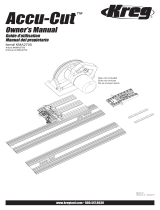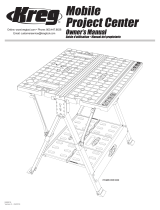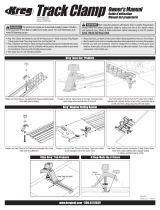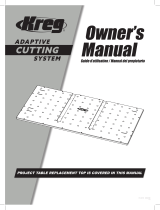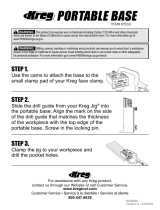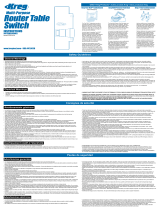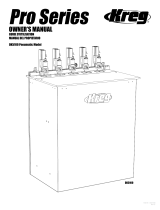
!
WARNING
When using electric tools, always follow the safety precautions below to reduce the risk of re, electric shock,
and personal injury. Read all these instructions before attempting to operate this product. SAVE THESE INSTRUCTIONS.
General Safety Guidelines
1) Work area safety
a) Keep work area clean and well lit. Cluttered or dark areas
invite accidents.
b) Don’t use power tools in a dangerous environment. Don’t
use power tools in damp or wet locations, or expose them
to rain.
c) Do not operate power tools in explosive atmospheres,
such as in the presence of flammable liquids, gases or dust.
Power tools create sparks that can ignite the fumes or dust.
d) Keep children and bystanders away while operating a
power tool. Distractions can cause you to lose control.
e) Make your workshop child proof. Use padlocks, master
switches, or remove starter keys.
2) Electrical safety
a) Ground electric tools. If the tool is equipped with a three-
prong plug, it must be plugged into a grounded three-hole
electri cal outlet. If the proper outlet is not available, have one
installed by a qualified electrician. Never remove the third
prong or modify the provided plug in any way.
b) Do not expose power tools to rain or wet conditions. Water
entering a power tool increases the risk of electric shock.
c) Do not abuse the cord. Never use the cord for carrying,
pulling or unplugging the power tool. Keep cord away
from heat, oil, sharp edges or moving parts. Damaged or
entangled cords increase the risk of electric shock.
d) Use a proper extension cord and make sure it is in good
condition. When using an extension cord, be sure to use one
heavy enough to carry the current your power tool draws. An
undersized cord causes a drop in line voltage resulting in
loss of power and overheating. Table 1 shows the correct
cord gauge to use depending on cord length and tool
nameplate ampere rating. If in doubt, use the next heavier
gage. The smaller the gauge number, the heavier the cord.
e) When operating electric tools, avoid body contact with
grounded or earthed surfaces such as pipes, radiators,
kitchen ranges, and refrigerators. Contact with a grounded
surface increases the risk of electric shock.
3) Personal safety
a) Stay alert, watch what you are doing and use common
sense when operating a power tool. Do not use a power tool
while you are tired or under the influence of drugs, alcohol
or medication. A moment of inattention while operating
power tools can result in serious personal injury.
b) Always wear safety glasses. Everyday eyeglasses are
not safety glasses. Safety glasses have specially constructed
lenses, frames, and side shields.
c) Use safety equipment. Use a face or dust mask when the
cutting operation is dusty. Safety equipment such as a dust
mask, non-skid safety shoes, hard hat, or hearing protection
used for appropriate conditions reduces personal injuries.
d) Avoid accidental starting. Make sure the switch is in the
off-position before plugging in. Carrying power tools with
your finger on the switch or plugging in power tools that
have the switch on invites accidents.
e) Remove any adjusting key or wrench before turning the
power tool on. A wrench or a key left attached to a rotating
part of the power tool can result in personal injury.
f) Do not overreach. Keep proper footing and balance at
all times. This enables better control of the power tool in
unexpected situations.
g) Secure workpieces. Use clamps or a vise to hold work
when practical. This is safer than using your hand and it
frees both hands to operate the tool.
h) Never stand on the machine. Serious injury can occur if
the tool tips or if the cutting tool is unintentionally contacted.
i) Dress properly. Do not wear loose clothing or jewelry. Keep
your hair, clothing and gloves away from moving parts.
Loose clothes, jewelry or long hair can be caught in moving
parts. Roll up long sleeves to the elbow. Wear protective hair
covering to contain long hair.
j) If devices are provided for the connection of dust extraction
and collection equipment, ensure these are connected and
properly used. Use of these devices reduces dust-related
hazards.
4) Power tool use and care
a) Keep guards in place and in working order.
b) Do not force the power tool. Use the correct power tool for
your application. The correct power tool will do the job better
and safer at the rate for which it was designed.
c) Use the right tool. Don’t force a tool or attachment to do a
job for which it was not designed.
d) Do not use the power tool if the switch does not turn it
on and off. Any power tool that cannot be controlled with the
switch is dangerous and must be repaired.
e) Disconnect the plug from the power source and/
or the battery pack from the power tool before making any
adjustments, changing accessories, or storing power tools.
Such preventive safety measures reduce the risk of starting
the power tool accidentally.
f) Never leave a tool running unattended. Turn power off.
Do not leave the tool until it comes to a complete stop.
g) Store idle power tools out of the reach of children and do
not allow persons unfamiliar with the power tool and
these instructions to operate the power tool. Power tools are
dangerous in the hands of untrained users.
h) Maintain power tools. Check for misalignment or binding
of moving parts, broken parts, and any other condition that
can affect power tool operation. If damaged, have the power
tool repaired before use. Many accidents are caused by
poorly maintained power tools.
i) Keep cutting tools sharp and clean. Properly maintained
cutting tools with sharp cutting edges are less likely to bind
and are easier to control.
j) Use the recommended speed for the cutting tool or
accessory and workpiece material.
k) Only use parts and accessories recommended by the
manufacturer. Consult the owner’s manual for recommended
accessories. Using improper accessories can cause personal
injury.
l) Use the power tool, accessories, and tool bits in
accordance with these instructions and in the manner
intended for the particular type of power tool, taking into
account the working conditions and the work to be
performed. Use of the power tool for operations different
from those intended can result in a hazardous situation.
5) Service
a) Have your power tool serviced by a qualified repair person
using only identical replacement parts. This ensures that the
safety of the power tool is maintained.
6) SAFETY INSTRUCTIONS SPECIFIC TO USING THE RIP-CUT
™
a) Before using the Rip-Cut
™
, read, understand,
and follow the safety warnings and operation
instructions included with this product and provided
by your saw manufacturer. Keep all guards and safety
devices in place.
b) Wear proper eye, ear, and respiratory protection when
operating your saw.
c) Use a sharp blade designed for the type of material you
are cutting.
d) Always disconnect your saw from power before making
adjustments to the saw or Rip-Cut
™
.








